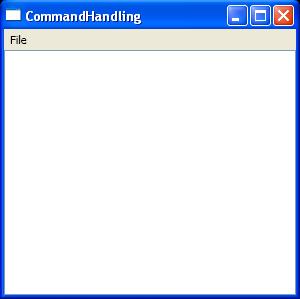<Window x:Class="WpfApplication1.Window1"
xmlns="http://schemas.microsoft.com/winfx/2006/xaml/presentation"
xmlns:x="http://schemas.microsoft.com/winfx/2006/xaml"
Title="CommandHandling" Height="300" Width="300"
>
<DockPanel>
<Menu DockPanel.Dock="Top">
<MenuItem Header="_File">
<MenuItem Command="New" />
</MenuItem>
</Menu>
<TextBox x:Name="inputBox" TextChanged="OnTextboxTextChanged" />
</DockPanel>
</Window>
//File:Window.xaml.cs
using System;
using System.Collections.Generic;
using System.Text;
using System.Windows;
using System.Windows.Controls;
using System.Windows.Data;
using System.Windows.Documents;
using System.Windows.Input;
using System.Windows.Media;
using System.Windows.Media.Imaging;
using System.Windows.Shapes;
namespace WpfApplication1
{
public partial class Window1 : Window
{
bool unsavedChanges = false;
public Window1()
{
InitializeComponent();
CommandBinding cmdBindingNew = new CommandBinding(ApplicationCommands.New);
cmdBindingNew.Executed += NewCommandHandler;
CommandBindings.Add(cmdBindingNew);
}
void NewCommandHandler(object sender, ExecutedRoutedEventArgs e)
{
if (unsavedChanges)
{
MessageBoxResult result = MessageBox.Show(this,"Save changes to existing document?", "New",MessageBoxButton.YesNoCancel);
if (result == MessageBoxResult.Cancel){
return;
}
if (result == MessageBoxResult.Yes){
SaveChanges();
}
}
inputBox.Clear();
}
private void OnTextboxTextChanged(object sender, RoutedEventArgs e){
unsavedChanges = true;
Console.WriteLine("changed");
}
private void SaveChanges(){
unsavedChanges = false;
Console.WriteLine("saved");
}
}
}
